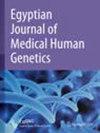The homozygous pathogenic variant of the POMGNT1 gene identified using whole-exome sequencing in Iranian family with congenital hydrocephalus
IF 1.2
Q4 GENETICS & HEREDITY
引用次数: 0
Abstract
Hydrocephalus is one of the most common pathophysiological disabilities with a high mortality rate, which occurs both congenitally and acquired. It is estimated that genetic components are the etiology for up to 40% of hydrocephalus cases; however, causal mutations identified until now could only explain approximately 20% of congenital hydrocephalus (CH) patients, and most potential hydrocephalus-associated genes have yet to be determined. This study sought to find causal variations in a consanguineous family with four affected children diagnosed with hydrocephalus. In this study, we evaluated twenty-five members of an extended family consisting of a nuclear family with four affected children resulting from a consanguineous couple and eighteen of their relatives, including one hydrocephalus case. The mother of this family was experiencing her 15th week of pregnancy, and cytogenetic evaluation was performed using amniocentesis to identify fetal chromosomal abnormalities. We conducted whole-exome sequencing (WES) on the genomic DNA of the proband to detect the CH-causing variants, followed by confirmation and segregation analysis of the detected variant in the proband, fetus, and family members through Sanger sequencing. Following the bioinformatic analysis and data filtering, we found a homozygous variant [NM_001243766.2:c.74G>A:p.W25X] within the protein O-mannose beta-1,2-N-acetylglucosaminyltransferase 1 (POMGNT1) gene confirmed by Sanger sequencing in the proband and segregated with the hydrocephalus in the family. The variant was described as pathogenic and regarded as a nonsense-mediated mRNA decay (NMD) due to the premature stop codon, which results in a truncated protein. The results of the current study broadened the mutational gene spectrum of CH and our knowledge of the hydrocephalus etiology by introducing a novel homozygous variant within the POMGNT1 gene, which had never been previously reported solitary in these patients.利用全外显子组测序在伊朗先天性脑积水家族中发现 POMGNT1 基因的同卵致病变体
脑积水是最常见的病理生理残疾之一,死亡率很高,既有先天性的,也有后天性的。据估计,遗传因素是高达 40% 的脑积水病例的病因;然而,迄今为止发现的因果变异只能解释约 20% 的先天性脑积水(CH)患者,而且大多数潜在的脑积水相关基因尚未确定。本研究试图在一个有四名确诊为脑积水患儿的近亲家庭中找到因果变异。在这项研究中,我们对一个大家庭的 25 名成员进行了评估,该大家庭由一对近亲夫妇及其 18 名亲属组成,其中有四名患儿,包括一名脑积水病例。该家族的母亲在怀孕第 15 周时进行了细胞遗传学评估,通过羊膜穿刺术确定了胎儿染色体异常。我们对该患者的基因组DNA进行了全外显子组测序(WES),以检测导致脑积水的变异体,然后通过桑格测序对检测到的变异体在患者、胎儿和家庭成员中进行了确认和分离分析。经过生物信息学分析和数据过滤,我们发现了一个同源变异体[NM_001243766.2:c.74G>A:p.W25X],该变异体存在于蛋白 O-甘露糖 beta-1,2-N-乙酰葡糖胺基转移酶 1(POMGNT1)基因中,通过 Sanger 测序,我们证实了该变异体存在于概率者体内,并与家族中的脑积水病例发生了分离。该变异被描述为致病性,并被认为是由于过早终止密码子导致的无义介导的 mRNA 衰减(NMD),从而产生截短蛋白。本研究的结果通过引入 POMGNT1 基因中的一个新的同源变体,拓宽了 CH 的基因突变谱和我们对脑积水病因的认识。
本文章由计算机程序翻译,如有差异,请以英文原文为准。
求助全文
约1分钟内获得全文
求助全文
来源期刊

Egyptian Journal of Medical Human Genetics
Medicine-Genetics (clinical)
CiteScore
2.20
自引率
7.70%
发文量
150
审稿时长
18 weeks
 求助内容:
求助内容: 应助结果提醒方式:
应助结果提醒方式:


